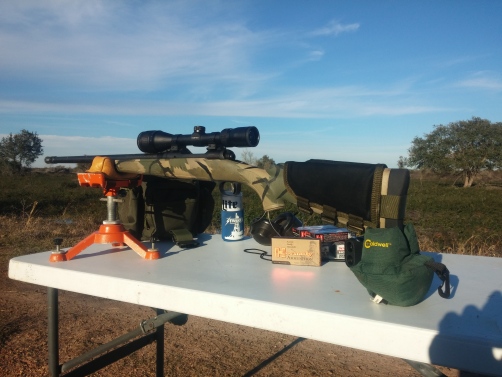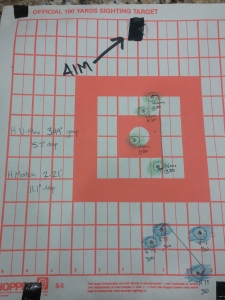What Rifle Do I Want?
Its always a good idea to get another gun, right? This past summer I got the bug to buy a new rifle to fill a gap in my arsenal. I have a Remington 700 in .270 caliber with a Luepold scope, which I love. This is primarily my deer hunting rifle, but I hardly shoot it due to my obsession with bow hunting, and it is too much gun and too costly for me to do much else with it. I also have a couple shotguns for some exciting wing shooting and friendly skeet competition. My side arm is a FN Herstal FNP 9mm. I was pretty happy with my collection, but I felt that I was missing a fun rifle to shoot for plinking and small game.
I wanted to get something that would be fun to shoot at the range without hurting the bank, accurate out to ranges beyond 200 yards, and could be used to hunt anything from rabbits to hogs. My first decision was to decide between the .17 HMR, .22 mag, .22 SWIFT, and .223. Ultimately, I went with the .223 for its fast velocity and flat trajectory, affordable options at any sporting goods store, and universal ability to hunt my desired game. Next I had to choose which rifle I wanted to purchase. There are lots of rifle options available for sportsmen in .223 caliber, and at a wide range of prices. For me, it came down to the Mossberg MVP, CZ 527, and Savage Hog Hunter. The CZ was at the top of my list, but also at the top of my budget. Also, I didn’t want a gun that I would be afraid for it to take a little abuse. The Mossberg was nice and had a detachable mag, but I was not a big fan of the stock and it didn’t seem to have a very strong following. Therefore, in the end, it was the Savage. I saw a lot of what I wanted in this gun, and it had a great retail price. The accutrigger was highly regarded in the many online forums that I read, but the Hog Hunter did not include the similarly touted Savage accustock. The biggest draw back to me for the Hog Hunter was that it did not have a detachable mag, but if I wanted to upgrade the stock in the future I could add this. I also really like the short bull barrel with a threaded end for muzzle accessories. I heard so many good things about out-of-box accuracy of Savage rifles, and had a good vision of how I could customize it.
Paint Job and Accessories
I knew I wanted to paint the stock of my new Savage and add some accessories to make it more “tactical”. The hardest decision for me was deciding what camo pattern I wanted to paint on the stock, and how I was going to do it. As you can see in my earlier post, I am a big fan of Predator Camo, and found a couple pictures online of rifles done this way. I also was a big fan of the Gap Camo pattern that many people did on their rifles. Most people suggest using Krylon ulta flat camo spray paint, but I read several complaints that it chipped too easily. Aervoe spray paint was said to be more durable and truer to military spec colors. I am a big fan of DIY and always like a little project to work on, so I decided to create my own Predator Camo templates and use Aervoe paint.
I cut my templates out of some stencil plastic I picked up at Hobby Lobby, but this stuff turned out to be too stiff and would not bend to the contours of the stock very well. It worked out better to cut stencils out of painter’s tape and apply it directly to the stock. First, I laid a think coat of Aervoe Sand for my base color over the existing olive colored stock. After letting it dry for about three hours, I applied my first set of stencils for color blocking. In retrospect, I should have allowed this to dry overnight because I had some of this layer peel off with the tape, but the olive stock underneath did not cause any obvious flaws. Maybe Krylon’s Fusion paint would be better for a base coat because it is supposed to bind better to plastics. Next I laid a layer of Aervoe Olive Drab and added more stencils after allowing it to dry overnight. Lastly, I used Aervoe Black to add the sticks for my DIY Predator Camo. For extra protection against wear I added a coat of ulta flat gloss. I was pumped about how great the Aervoe paint was looking, and couldn’t wait for everything to dry so I could remove all the stencils. I have to admit, I think I did a pretty damn good job for my first paint job! This thing was already starting to look sweet. (I took pictures of each step as I painted the rifle, but I can’t find the sd card now. Sorry!)
When I purchased my Hog Hunter, the awesome folks at CenTex Guns suggested that I look for a Vortex scope from Optics Planet. He said that Vortex could not be beat for the money, not to mention their lifetime warranty, and I was able to get a bargain from Optics Planet. I picket up a Vortex Diamondback 4x12x40 with an adjustable objective for long range shots and the all-purpose V Plex Reticle. As they say, you gotta spend equal money on your scope and rings as you do on your rifle. I got an awesome deal on the scope and decided to go with some Luepold PRW scope rings from MidayUSA. My Hog Hunter was nearly set up. For finishing touches I added a simple A2 style muzzle brake and a Tac Ops multi-cam cheek pad for a more tactical look. This gun was now begging me to shoot it!
Sighting In and Range Report
I sighted in my new rifle at 100 yards with less that 10 rounds down range. I set up to bore sight it, but didn’t even need to make any adjustments. A few shots from 100 yards and several clicks to the Vortex and I was on! I was immediately impressed with the tight groups that I was making, even with cheap ammo.
Let me preface my range report by stating that I am an amateur long distance shooter that only takes a handful of 100 yard shots with my 270 each year. With that said, I do still consider myself a pretty dang good shot! My first range test with the Savage was at 100 yards with four different types of ammo to test for accuracy in four shot groups. The American Eagle .223 55 gr. FMJ shot surprising well with a center-to-center group size of 1.34”. This load is readily available and has a very budget friendly price, so I was very pleased to see how well it shot. I also bought two different varieties of Winchester ammo, which I was unimpressed with. The Winchester Varmint X 55 gr. polymer tip had a group size of 2.59” and the Winchester Hog Special 64 gr. soft tip had a group size of 3.13”. The load that shot lights out above and beyond the previous three was some Hornady Match grade 75 gr. BTHP. I read that a 1 in 8” twist barrel would not group something heavier than 70 grains very well, but the Hornady’s 0.652” group certainly contests that statement. Sub-MOA on my first range test with the Savage Hog Hunter!
On my next trip to the range I was excited to test the long range capability of the Savage, and of myself for that matter. I had no prior experience shooting at a target beyond 200 yards, and on this trip I set up at 200 yards and 300 yards. The magnification and clarity of the Vortex 4x12x40 OA was remarkable and easily capable of settling my crosshairs on a 300 yard target. For this range test I used the same ammo described above, except I replaced the Winchester Hog Special with some Hornady Superformance Varmint 53 gr. V-Max. The Hornady Supers claim to increase rifle performance by up to 200 fps for unattainable performance in other brands. Again, I shot four shot groups from each load at 200 yards and then again at 300 yards. I wanted to see how tight the same groups held at longer distances, and I also wanted to record how much drop to expect for future scope elevation adjustments. At 200 yards the American Eagle 55 gr. FMJ shot a center-to-center group of 2.92” with 1.81” drop. The Winchester Varmint X 55 gr. shot a 2.70” group with 1.19” drop. The Hornady Match 75 gr. shot a 1.72” group with 1.31” drop. The Hornady Supers shot a 2.78” group with 2.0” drop. At 300 yards the American Eagle loads shot a 6.91” group with 9.1” drop. The Winchester shot a 3.21” group with 8.6” drop. The Hornady Match shot a incredible 2.21” group with with 11.1” drop. Lastly, I believe the speed claim on the Hornady Superformance box after seeing them group at 300 yards with a 3.49” center-to-center spread and a mere 5.7” drop. Below is a picture of the 300 yard groups with the Hornady Match in blue and the Hornady Superformance in green. All the results are hard to follow in text, so I put everything into the table below.
As I mentioned earlier, this was the first time for me to shoot at a target beyond 200 yards, and I couldn’t believe that I shot a 2.21 inch group! Hornady ammo has a very good reputation and from my range tests it shows to be the best .223 ammo for my Savage Hog Hunter. Overall, I am very happy with the look of my new rifle, and it fits all the criteria that I was looking for. In my opinion, the gun looks sweet with some sniper/tactical flare. Out of the box, I am getting excellent shot groups from 100 yards out to 300 yards. Lastly, the wide variety of ammo choices and bullet weights should make shooting anything from paper to rabbits to hogs a lot of fun, and ethical too.
Hard Work and Fearless Faith



